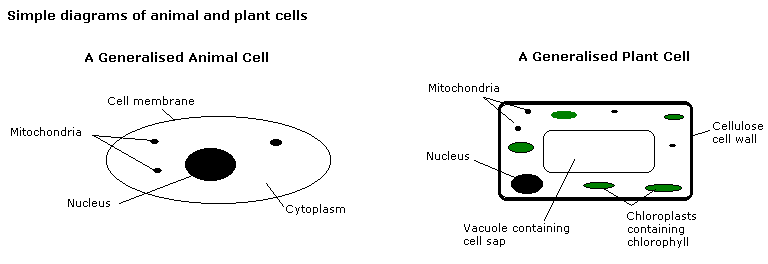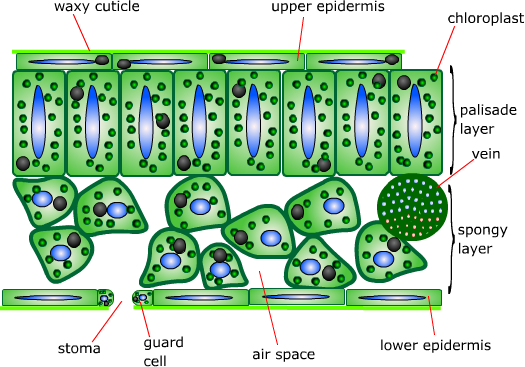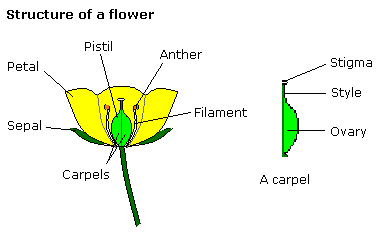Cards In This Set
| Front | Back |
|
Cells
|
 All animals and plants are made up of cells. Most cells have:
|
|
Cells, tissues and organs
|
Cells act together to form tissues. For instance, the cells on the
surface of a leaf form "pallisade tissue". A group of cells with
similar structures and a particular function are called a tissue.
Tissues are grouped together to form an organ. A leaf is an organ.
Organs are grouped together to form an organism such as a whole plant
or animal.
Cells ----> Tissue ----> Organ ----> Organism
Tissues are usually formed from specialised cells. The cells in the
pallisade tissue are specialised to perform photosynthesis and contain
many chloroplasts. Some other specialised cells are:
|
|
Diffusion
|
Diffusion is the net movement of particles from an area of high
concentration to an area of a lower concentration. The steeper the
concentration gradient, the more rapid the rate of diffusion.
2 examples of diffusion are:
|
|
Osmosis
|
Osmosis is the movement of water from an area of high water
concentration (more dilute) to an area of a low water concentration
(stronger) through a partially permeable membrane.
A partially permeable membrane allows water molecules to pass
through (as they are smaller) but not solute molecules (they are too
big). It acts like a sieve. Visking tubing is a partially permeable
membrane. It is used in dialysis machines.
|
|
Active Transport
|
Diffusion and osmosis can only work if the concentration gradient is
right. Sometimes an organism needs to transport something against a
concentration gradient. The only way this can be done is through active
transport, using energy produced by respiration. In Active transport,
the particles move across a cell membrane from a lower to a higher
concentration.
Examples of active transport In plants: Plants need mineral salts (e.g. nitrates) for making proteins and growth. Nitrates are at a higher concentration inside the root cells than they are when dissolved in the water around the soil particles. If the plant relied on diffusion alone, the vital nitrate salts would drain out of the cells into the soil. So energy is deployed by the cells to actively transport nitrates across the cell membrane into the root cells, against the concentration gradient. In humans Active transport takes place during digestion of food in the small intestine. After food has been absorbed by the villi for some time, the concentration of food molecules inside the villi increases, making it impossible for more food to diffuse into the villi. So simple sugars, amino acids, minerals and vitamins are actively absorbed into the villi, from an area of lower to an area of higher concentration Shareen Saqlain |
|
The Cell Cycle
|
Happens in cells
|
|
Prophase
|
The first and longest phase of mitosis, prophase, can take as much as
50-60 percent of the total time to complete mitosis. During prophase,
the chromosomes become visible. The centrioles, two tiny structures
located in the cytoplasm near the nuclear envelope, separate and take
up positions on opposite sides of the nucleus. The centriols lie in a
region called the centrosome that helps to organise the spindle, a
fanliek microtubule structure that help separate the chromosomes.
During prophase, the condensed chromosomes become attached to fibers in
the spindle at a point near the centromere of each chromatid.
|
|
Metaphase
|
The second phase of mitosis, metaphase, often only lasts a few minutes.
During metaphase, the chromosomes line up across the center of the
cell. Microtubules connect the centromere of each chromosome to the
poles of the spindle.
|
|
Anaphase
|
Anaphase is the third phase of mitosis. During anaphase, the
centromeres that join the sister chromatids separate, allowing the
sister chromatids to separate and become individual chromosomes. The
chromosomes continue to move until they have separated into two groups
near the poles of the spindle. Anaphase ends when the chromosomes stop
moving.
|
|
Telophase
|
Following anaphase is telophase, the fourth and final phase of mitosis.
In telophase, the chromosomes, which were distinct and condensed, begin
to disperse into a tangle of dense material. A nuclear envelope
re-forms around each cluster of chromosomes. The spindle begins to
break apart, and a nucleolus becomes bisible in each daughter nucleus.
Mitosis is complete
|
|
Plant structure
|
Plants are divided into flowers, stems, leaves and roots with root hairs. A generalised plant is shown in the illustration.
|
|
The structure of the leaf
|
 Leaves produce the food for the plant. The structure of the leaf is shown in the illustration. The leaf has prominent veins that contain two types of tubes, the xylem tubes and the phloem tubes. The leaf has the following parts (from top to bottom):
|
|
The structure of flowers
|
 Lowers are composed of:
  |
|
Plant growth
|
Plant growth requires glucose produced by photosynthesis and energy
produced by respiration. It also requires minerals obtained from the
soil. Plant growth is controlled by plant hormones called auxins.
Auxins
Minerals needed for plant growth
There are three minerals that are essential for plant growth: phosphates, nitrates and potassium. Small quantities of iron and magnesium are also needed, especially for the production of chlorophyll.
Phosphates: used in photosynthesis and respiration. Phosphate deficiency: purple leaves and small roots.
Nitrates: used in the production of aminno acids. Amino acids are combined to make proteins.
Nitrate deficiency: yellowing of leaves and poor, stunted growth. Potassium: maintains electrical potentials and helps enzyme action. Potassium deficiency: leaves become yellow with spotty, brown, dead areas. |
|
Photosynthesis
|
Like all living things, plants need food to live. This food is used
for energy and to make new materials when plants grow. Plants are able
to take two inorganic chemicals, carbon dioxide gas and water, to make
an organic chemical, glucose. This simple food can be used as an energy
source or converted into other useful organic molecules.
The process requires an input of energy. Plants have found a way to
capture the energy from sunlight using a pigment called chlorophyll.
Once this light energy has been captured it can be used to create
glucose, converting the light energy into chemical energy. Oxygen gas
is released as a waste chemical. As light energy is used to create
organic materials the process is named Photosynthesis.
The formula for photosynthesis is:

 |



